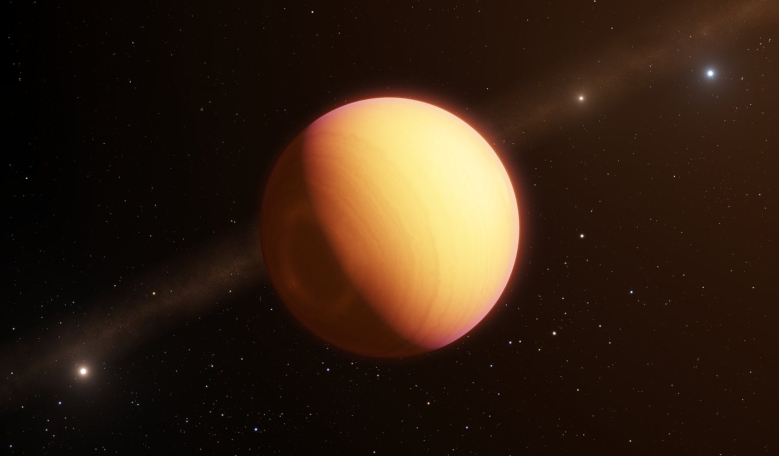A storm-wracked exoplanet with swirling clouds of iron and silicates has been spotted by an instrument which uses the light of four telescopes to see features ten times more detailed than was previously possible.
The instrument is GRAVITY and it was born from the desire to observe very small details on faint objects. It sits on ESO’s Very Large Telescope Interferometer (VLTI) and represents a huge step forward in observing objects in visible light.
Interferometry works by combining light, be it radio waves or visible light, from two or more telescopes to act as one unit. The distance between two telescopes, also known as the separation, forms a baseline, which effectively becomes the diameter of the “virtual” telescope created by the interferometry.
Its no good though just placing two small telescopes 10 metres apart say, to make the equivalent of a telescope 10 metres in diameter, you need a few to help pick out the details of what it is you are looking at, so the more baselines that are used, the more information can be gleaned about an object. The Atacama Large Millimetre/Submillimetre Array (ALMA) is a one example of many antennas working together as one to see the cosmos in finer detail than ever before.
Unlike ALMA, GRAVITY uses visible light (not Millimetre/Submillimetre radiation) to spot its targets and by using the VLTI it can function the same as an equivalent telescope of up to 100 metres in diameter when looking in certain directions in the sky. GRAVITY’s very high resolution and sensitivity has enabled scientists to hone in on HR8799e; a super-sized world unlike any found in our Solar System.
The exoplanet was first discovered in 2010 when it was found orbiting its young main-sequence host star HR8799, which lies around 129 light-years from Earth in the constellation of Pegasus. Not much was known about it other than its size – it is between five and ten times the mass of Jupiter – and its age.
HR8799e may be massive, but it is young - just 30 million years old, but its relative youth can help scientists work out how planets and planetary systems form. HR8799e is also completely inhospitable too; the exoplanet suffers from a powerful greenhouse effect – a bit like Venus – which heats the super giant to a scorching hot temperature of roughly 1000 °C.
The exoplanet also wouldn’t have very pleasant ‘air’ to breathe if you could get close enough to a surface (if it has one) as an equivalent atmosphere here on Earth would poison if not kill you.
“Our analysis showed that HR8799e has an atmosphere containing far more carbon monoxide than methane — something not expected from equilibrium chemistry,” explains team leader Sylvestre Lacour researcher CNRS at the Observatoire de Paris - PSL and the Max Planck Institute for Extraterrestrial Physics. “We can best explain this surprising result with high vertical winds within the atmosphere preventing the carbon monoxide from reacting with hydrogen to form methane.”
And let’s not forget about the clouds that rain down ingredients which would give you a good facial if whipped up in a storm.
“Our observations suggest a ball of gas illuminated from the interior, with rays of warm light swirling through stormy patches of dark clouds,” says Lacour. “Convection moves around the clouds of silicate and iron particles, which disaggregate and rain down into the interior. This paints a picture of a dynamic atmosphere of a giant exoplanet at birth, undergoing complex physical and chemical processes.”
It is thanks to GRAVITY’s superb optical interferometry ability that means planets such as HR8799e can be viewed and characterised from afar - the best place to be when worlds such as these present such inhospitable environments.











